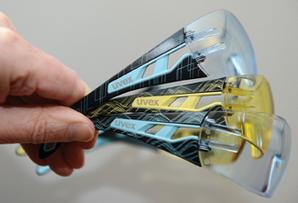By Angie DeRosa
CONFERENCE DIRECTOR
Published: October 22, 2013 1:15 pm ET
Updated: October 22, 2013 1:38 pm ET

Image By: Caroline Seidel, Plastics News
Special protective eyewear form Uvex Winter Holding
DÜSSELDORF, GERMANY — The iPhone 5c illustrates a point several speakers made at Design Chain @ K: that materials, chief among them plastics, will help drive consumer stories.
Individualization and unique branding are where Apple excels, said conference Chairman Chris Lefteri. "What they've done a very good job at is to tell us how we feel," Lefteri said. "The future is built on telling consumer stories."
When Jony Ive, Apple Inc.'s design chief, said the iPhone 5c was "unapologetically plastic," it earned the attention of not only the plastics industry but of industrial designers, and hinted at where plastics are headed.
It won't be a vision of the future like "The Jetsons," where multicolored, multiformed sculptures populate the built environment. That image was popular in the 1970s and 1980s, but attitudes have changed about plastics.
"We've kind of lost that," said Lefteri, a London-based industrial designer by training and an expert on materials, although he stressed that the industrial design community could never be what it is without plastics.
"Plastics did change the way the world looks. But plastics will not do this in the future. Plastics will play a different role."
It's the intangible aspects of plastics that will make it so powerful in this new consumer mindset and transform products. How does the product make a person feel? Will it make life better? Does it deserve to exist?
Still, the ultimate challenge is to turn consumer needs into successful products and take out as much risk as possible, a point illustrated by speakers Oscar Brocades Zaalberg, managing director of BPO, a product development and engineering firm based in Delft, Netherlands, and Ulf Trabert, unit manager of cosmetic brand packaging with Gabriel-Chemie Deutschland GmbH of Gumpoldskirchen, Austria.
Zaalberg's company uses advanced simulation technologies to work out kinks well before any molds are designed. His firm helped Hein¬eken convert a beer keg to PET, and Samsonite develop a thin-walled polypropylene suitcase.
In Samsonite's case, the goal was to cut the weight of the suitcase by 20 percent.
"You can use simulations to be on target. Through all those simulations, we could make adjustments in the design process, not in the tool," he said. "This was a huge success for Samsonite."
Gabriel-Chemie's Trabert said consumers are overwhelmed at the point of sale. It is challenging to make products stand out on the shelf. But through decoration, color, special effects and other techniques, that can be achieved.
In a world with constantly changing dynamics where the riches are in niches, consumers also want personalization. One example: Uvex Winter Holding GmbH & Co. KG of Fürth, Germany, has used laser decoration in its line of protective glasses. These are intended for safety, but even in that environment, consumers want individualization.
Laser decoration offers a high level of flexibility, even on the structured surfaces of the plastic glasses. It is the emotional connection and how it is expressed through products, said Lefteri, that matter to consumers. The design world is figuring it out, partnered with plastics.
Lefteri and Marcel Dartee, global marketing director of sustainable solutions and biomaterials at PolyOne Corp., explored a solar power charger project in a joint presentation at the conference.
Lefteri and PolyOne worked on the project with Xindao, a Rijswijk, Netherlands, company that traditionally has sold inexpensive gifts made by manufacturers in China. But Xindao's new strategy is to make original products, and the firm has hired a design team to help achieve its goals.
"They are very serious about being design-led as a company and being sustainable in their design," Lefteri said.
The Sunshine Solar Charger was designed by Ryan Mesorley at Xindao to resemble a plant, where the "flowers" are small solar panels that collect enough energy to charge a smart phone or tablet.
The plastic parts of the charger are made from PolyOne's ReSound polymers. This is a family of polymer blends, where durable polymers such as polycarbonate or ABS are blended with polymers derived from renewable sources, such as polylactic acid.
The Design Chain @ K conference is organized by Crain Communications Ltd. and is the first design-centered conference at the K show. The event continues Oct. 22 on the second floor in CCD South, Room 16.
David Eldridge of European Plastics News contributed to this story. | 